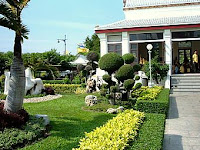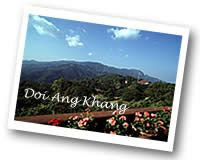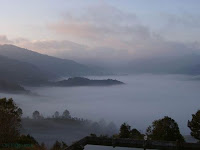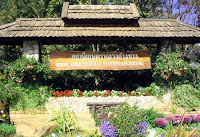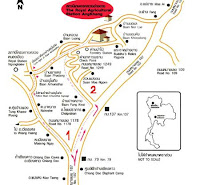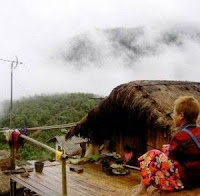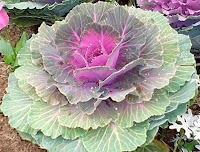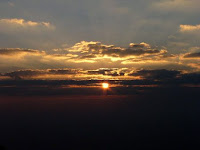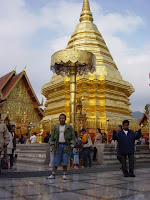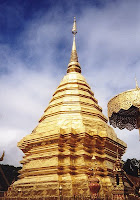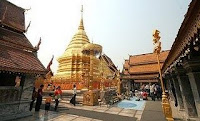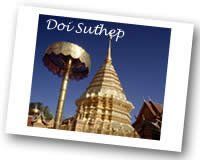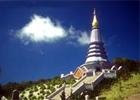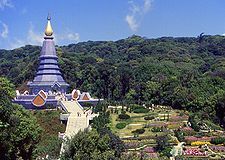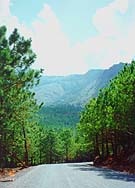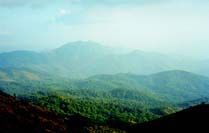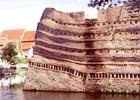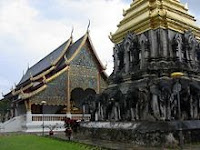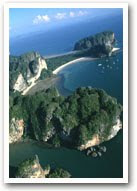 |
| Phra Kaew Morakot |
The First Must Visited Temple in
Bangkok.
Wat Phra Sri Ratana Sasadaram, officially called the temple of the Emerald Buddha or Wat Phra Kaew, had built in the reign of “King Rama I”, Phra Bat Somdej Phra Phuttha Yod Fa Chula Lok Maha Raja, the founder of the Chakri Dynasty. The construction work had begun in 1782 and completed in 1784. The temple of the Emerald Buddha, the royal chapel, is located east, adjoining the Grand Palace. The temple is particularly built to house the Emerald Buddha, a Buddha image which King Rama I brought from Vientiane when he captured the city.Although it is the most national sacred temple, there is no any resident monk. But, it has only elaborately decorated holy buildings, statues, and pagodas.The Emerald Buddha or Phra Kaew Morakot, the highly revered Buddha image, meticulously carved from a huge block of Jade. It is the Buddha image in the seated meditating position, in the style of the Chiang San School on the north of Thailand.
 |
| Wat Phra Kaew |
The Emerald Buddha was first discovered in Chiang Rai province in the reign of King Triloknatha (1441-1487). Later, it was taken to several important cities such as Lampang, Chiang Mai, Luang Phra Bang, and Vientiane.When 1778 King Rama I overcame over Laos, he had brought it back at Wat Arun in Thon Buri, the capital at that time. And, in 1785, the Emerald Buddha was transferred from Wat Arun to Wat Phra Kaew and then shrined in the Phra Ubosoth (ordination hall) until now.
The Royal Pantheon or Prasat Phra Thep Bidon, originally called Buddha Prang Prasat, was built in the reign of King Rama IV in 1855. This building is a pavilion with four-square Prangs. It is initially considered to enshrine the Emerald Buddha, but too small to accommodate the congregation at royal ceremonies. Now it is used for keeping statues of deceased 8 kings of Chakri Dynasty.On the four-sides of cloisters like-galleries (Phra Rabiang) around Phra Ubosoth, there are the Mural Paintings depicting Ramakien epic (The Thai version of the Hindu epic, Ramayana). These paintings consist of 178 sections, firstly done in the reign of King Rama I. Later, some parts of Phra Rabiang and paintings were renovated from time to time in the present Chakri Dynasty.
The paintings of Ramayana epic around Phra Rabiang start from north door turn to the west.
The golden Stupa, Phra Sri Ratana Chedi, has a bell shape which is the Ceylonese style. The chedi was built by Rama IV to house a relic of the Buddha. Its form imitates the large chedi of Phra Sri Sanphet temple in Ayutthaya, the former capital of Thailand. Later, in the time of King Rama V had applied the golden tile mosaics to the Chedi.
Phra Mondop, Ho Tri, or the library, was built in the time of King Rama I, containing the new copy of Tipitaka (important Buddhist scriptures). Phra Mondop is based on the Pillars and located between Phra Sri Ratana Chedi and The Royal Pantheon. However, it is almost always closed to the public.
If you have a free time, you can visit Patron Rub ushi, Gate-keeping Giants, Phra Vihara Yod (The spired Hall), Model of Angor Wat, The lined Pavilions (Sala Rai), etc.
This is the guide of the first Temple in Bangkok in
ThaiLook.Blogspot.com
How to getting to Wat Phra Kaew
Located within the Grand Palace, near Sanam Luang, Phra Nakorn District, Bangkok
Tel No. 02 623-5500 ext. 1830, 3100
By Bus - 1, 2, 3, 9, 15, 19, 25, 30, 32, 33, 39, 42, 43, 44, 47, 53, 59, 60, 64, 65, 68, 70, 79, 80, 82, 91, 123, 124, 201, 203, 503, 508, 512
By Air-conditioned Bus - 1, 6, 7, 8, 12, 25, 38, 39, 44, 59, 524
By Chaopraya river - Tha Chang pier
Temple Talk
There are hundreds of Thai Buddhist temples (Wat) in Bangkok. Several of these will vary in styles and sizes but will consist of the principles of Buddhist architecture. Many visitors may not be familiar with the structures inside a temple-compound. Therefore, this part will recommend you the concise meaning of Thai Buddhist temple terminology.
Wat
Other words are Thai Buddhist temple or monastery. In general, Wat is substitutes for the collection of several Buddhist structures within the courtyard and enclosed by walls with several gateways.
Anyway, in Thailand the chief religious architectures are Chedi, Ubosoth, Vihara, Prang, Mondop and Prasat. The other buildings that are not very essential - Kuti, Ho Trai, Sala and Ho Rakhang.
Bot or Ubosoth
Other words are Ordination Hall or Convocation Hall or Assembly Hall. Ubosoth are always used for Buddhist clergy performing ritual of the monastic community or other significant ritual ceremonies. Another meaning, Ubosoth is the heart of the monastery and would be a monk centre.
Besides, Ubosoth will always enshrine the Buddha statue. Ubosoth may generally have three doors, both at the front and one at the rear of Ubosoth. The exterior of Ubosoth will be observed by the six boundary stones (Bai Sema or Sema stones). There will only be one Ubosoth in the temple. Some temples may not give the public permission to enter Ubosoth. Only the monks can be permitted to perform ritual ceremonies.
Viharn or Vihara
The sermon hall or Buddhist Monastery is used for enshrining major Buddha statues. Actually, Vihara is a replica of Ubosoth. In Bangkok and the central of Thailand, most Vihara are usually smaller than Ubosoth.
Viharn always opened to everyone to meet and pray together. There are no Sema stones surrounding Vihara like Ubosoth. Maybe, there are several Vihara within the temple.
Sema (Bai Sema or Sema stone)
The marks of boundary are made of stone slabs and represent the sacred ground of the temple. They are usually in leaf-shaped stone, putting up right from the ground and always surrounded Ubosoth by eight boundary stones. However, Sema in some temples had nicely been decorated.
Chofah
Chofah are the decoration as the horn-like finials (gable apex) on the roof ridges of temples. They represent the ‘Garuda’ head, the mythical bird.
Chedi
Other words are pagoda or stupa. Chedi is generally bell-shaped solid structure. In Thailand, Chedi is the most holy sacred religious structure in Thai temple because the underneath of the interior area of Chedi will always contain some relics of the Buddha and some are built to contain some relics of the magnificent revered Buddhist monks.
The prototype of Chedi originated in central India. In Thailand, we are able to see Chedi or Stupa of the classic type in several various forms. However, the round chedi that were often built in Bangkok and the central of Thailand. It has the same elements as the Indian prototype which was introduced from Sri Lanka - a high drum formed by many moldings of the same design, a bell-shaped dome, a square throne surmounted by a low circular colonade supporting the high and slender Chatra (umbrella)
Prang
The Khmer-style religious architecture (Khmer prang), a vertical tall finger-like spire and usually elaborately carved. Later, this feature was later adopted by Thai important religious architecture. Usually, Prang has three niches and one entrance door toward a very steep staircase. The internal area sometimes contains Buddha statues.In Bangkok, Prangs can be easily found in several Buddhist temples such as Wat Phra Kaew (The temple of Emerald Buddha), Wat Pho, Wat Arun, etc. However, Prangs can be conveniently seen in North-East region of Thailand, such as Phimai Prang, Phanomrung Prang, etc.
Sala
Generally, Sala is any open-sided pavilion. In a temple, these may be used for sermon and resting place to the public.Like magnificent structures, some Sala were ornamented with glazed tiles and beautiful gilded decoration on the gables.
Ho Trai and Mondop
Other words are Ho Phra or the scripture hall or Buddhist library of the temple. Thai Mondop will be similar to Mandapa of Indian temples.Mondop is usually a very small and highly decorated building. However, Mondop may be a quare-shape structure, entirely made of bricks. Their pyramidal upper part is formed by two or three layers of roofing or usually topped with a spire section (spire library). Anyway, some Mondop were made of wooden roofing, decorated with wooden carvings, gilded and enriched with multi-color glass mosaics.
Ho Trai or Mondop is the place to contain the Tipitaka (Teachings of Buddha or The Buddhist Scriptures), other important Buddhist religious sacred manuscripts, and some holy objects. Some Mondop may also serve as store room for holy opjects used in religious ceremonies.
Belfry or Bell Tower (Ho Rakhang)
In Thailand, the belfry generally has no special artistic attraction. Normally, belfry is shaped with four wooden or brick poles, and provided a high platform with steps on one or four sides. A pyramidal roof is built over the platform and the bell is suspended within.
Kuti
Normally, Thai temples have the residential section of monks (Sangghavas). Kuti is monks’ living place and varied in several sizes and shapes with simply construction, and no any artistic features.










